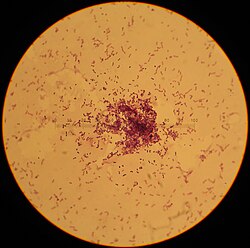Lactococcus lactis
| Lactococcus lactis | |
|---|---|

| |
| Klasifikasi ilmiah | |
| Domain: | |
| Kerajaan: | |
| Filum: | |
| Kelas: | |
| Ordo: | |
| Famili: | |
| Genus: | |
| Spesies: | L. lactis
|
| Nama binomial | |
| Lactococcus lactis (Lister 1873)
Schleifer et al. 1986 | |
| Subspesies | |
|
L. l. cremoris | |
Lactococcus lactis adalah bakteri gram positif yang digunakan secara ekstensif dalam produksi susu mentega and keju,[1] namun juga menjadi terkenal sebagai organisme rekayasa genetika pertama yang digunakan untuk pengobatan penyakit manusia.[2] Sel L. lactis merupakan kokus yang berkelompok secara berpasangan dan membentuk rantai pendek, dan, tergantung pada kondisi pertumbuhan, tampak berbentuk bulat telur dengan panjang khas 0,5−1,5 μm. L. lactis tidak menghasilkan spora (nonsporulasi) dan tidak motil (nonmotil). L. lactis memiliki metabolisme homofermentatif, yang memiliki arti bahwa bakteri ini menghasilkan asam laktat dari gula. L. lactis pernah dilaporkan memproduksi L-(+)-asam laktat eksklusif.[3] Namun,[4] dilaporkan pula D-(−)-asam laktat yang dapat diproduksi bila dikultur dengan pH rendah. Kemampuan untuk memproduksi asam laktat adalah salah satu alasan mengapa L. lactis merupakan salah satu mikroorganisme terpenting dalam industri susu.[5] Berdasarkan sejarahnya dalam fermentasi makanan, L. lactis memiliki status secara umum dikenal sebagai aman (GRAS)[6][7] dengan sedikit laporan kasus sebagai patogen oportunistik.[8][9][10]
Referensi sunting
- ^ Madigan M, Martinko J (editors). (2005). Brock Biology of Microorganisms (edisi ke-11th). Prentice Hall. ISBN 0-13-144329-1.
- ^ Braat H, Rottiers P, Hommes DW, Huyghebaert N, Remaut E, Remon JP, van Deventer SJ, Neirynck S, Peppelenbosch MP, Steidler L (2006). "A phase I trial with transgenic bacteria expressing interleukin-10 in Crohn's disease". Clin Gastroenterol Hepatol. 4 (6): 754–759. doi:10.1016/j.cgh.2006.03.028. PMID 16716759.
- ^ ROISSART, H. and Luquet F.M. Bactéries lactiques: aspects fondamentaux et technologiques. Uriage, Lorica, France, 1994, vol. 1, p. 605. ISBN 2-9507477-0-1
- ^ Åkerberg, C.; Hofvendahl, K.; Zacchi, G.; Hahn-Hä;gerdal, B. (1998). "Modelling the influence of pH, temperature, glucose and lactic acid concentrations on the kinetics of lactic acid production by Lactococcus lactis ssp. Lactis ATCC 19435 in whole-wheat flour". Applied Microbiology and Biotechnology. 49 (6): 682–690. doi:10.1007/s002530051232.
- ^ Integr8 - Species search results:
- ^ FDA. "History of the GRAS List and SCOGS Reviews". FDA. Diakses tanggal 11 May 2012.
- ^ Wessels, S., Axelsson, L., Bech Hansen, E., De Vuyst, L., Laulund, S., Lähteenmäki, L., Lindgren, S.; et al. (November 2004). "The lactic acid bacteria, the food chain, and their regulation". Trends in Food Science & Technology. 15 (10): 498–505. doi:10.1016/j.tifs.2004.03.003.
- ^ Aguirre M, Collins MD (August 1993). "Lactic acid bacteria and human clinical infection". J. Appl. Bacteriol. 75 (2): 95–107. doi:10.1111/j.1365-2672.1993.tb02753.x. PMID 8407678.
- ^ Facklam RR, Pigott NE, Collins MD. Identification of Lactococcus species from human sources. Proceedings of the XI Lancefield International Symposium on Streptococci and Streptococcal Diseases, Siena, Italy. Stuttgart: Gustav Fischer Verlag; 1990:127
- ^ Mannion PT, Rothburn MM (November 1990). "Diagnosis of bacterial endocarditis caused by Streptococcus lactis and assisted by immunoblotting of serum antibodies". J. Infect. 21 (3): 317–8. doi:10.1016/0163-4453(90)94149-T. PMID 2125626.